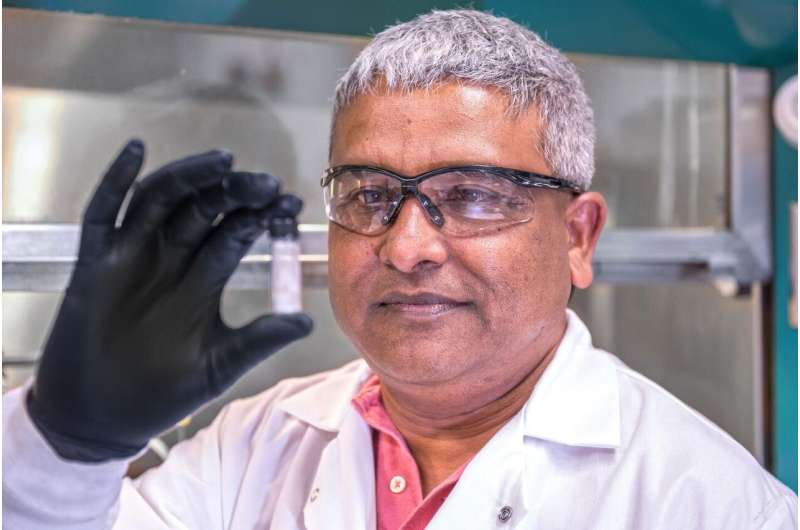Dr. Anit Giri, a physicist with the US Army Research Laboratory, observes a sample of a unique aluminum nanomaterial powder that reacts with water to produce hydrogen. Credit: David McNally/Army Research Laboratory
The U.S. Army announced that it signed a patent license agreement with a Chicago-based hydrogen fuel company that hopes to disrupt transportation and portable energy markets.
The tech transfer agreement allows H2 Power, LLC, to sell a new aluminum alloy powder for safe, on-demand hydrogen fuel cells.
"The powder is safe to handle, is 100% environmentally friendly, and its residue can be recycled an unlimited number of times back into aluminum, for more powder. Recycling apart, only water and powder are necessary to recreate this renewable energy cycle, anywhere in the world," said H2 Power CEO Fabrice Bonvoisin.
"For example, this technology enables us to transform existing gas stations into power stations where hydrogen and electricity can be produced on-demand for the benefit of the environment and the users of electric and hydrogen vehicles or equipment. We can't wait to work with OEMs of all kind to unleash the genuine hydrogen economy that so many of us are waiting for," he said.
Scientists at the Army Research Laboratory discovered the structurally-stable, aluminum-based nanogalvanic alloy in 2017 and then filed for the patent. The powder reacts with water or any water-based liquid to produce on-demand hydrogen for power generation without a catalyst.
According to the Army's notice in the Federal Register, H2 Power's license agreement, which TechLink helped facilitate, gives the startup exclusive use of the invention for automotive and transportation fuel and for 15-kilowatt or larger electrical generators.
Brian Metzger, a senior technology manager at TechLink, works with the lab's technology transfer office to market its technology portfolio.
Metzger said there's still an opportunity for other companies to obtain license agreements that contain other fields of use.
"One company has been given the exclusive license for a particular use, but several other companies are in negotiations, and there's probably room for a few more," Metzger said.
For example, the Army is interested in seeing if the technology could be developed into a form factor capable of acting as an auxiliary power source for handheld radios.
"This material is unique," said Dr. Kris Darling, a materials scientist at the Army lab. "It was discovered just a few years ago, so a manufacturing base doesn't exist. That's why we're going to work directly with the people licensing this technology—so they can build the infrastructure and gain the manufacturing science and engineering to be able to rapidly scale this."
Having the manufacturing base is essential, Darling said, because it opens up the technology for military and non-military applications.
"It's important because the Army can benefit from this product being produced," he said.
Provided by TechLink























